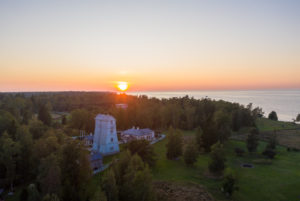In the middle of the 19th century, sailors continuously complained about the poor condition of the navigational equipment in the Russian waters. In 1859, a wooden beacon was built in Suurupi, 2245 m from the Rear Lighthouse. Lantern chamber finished in 1885. Together with the stone Rear Lighthouse, they form a target of 246.5⁰, which facilitates departure from Tallinn Bay from between Naissaar and Vahemadal in a westward direction into the Gulf of Finland. In 1863, the eastern wall was painted white, the sides and the rear wall were painted yellow and the roof red. An overseer’s dwelling, a barn and a well were built near the lighthouse. In 1888, the sheeting was renewed and all sides were painted white. A stone kerosene house was added to the station. In 1911, a new wooden house was built. In 1967, the lighthouse was converted to electric power and synchronized with the upper lighthouse. In 1998, the Suurupi Front Lighthouse was restored. The Suurupi Front Lighthouse is one of a hundred working historical lighthouses of the International Association of Marine Aids to Navigation and Lighthouse Authorities (IALA). The whole complex is under state protection as a cultural heritage.
Suurupi Lighthouse Front used oil lamps at first, then gas and in 1967 the beacon was electrified.
 Suurupi.Travel
Suurupi.Travel 


